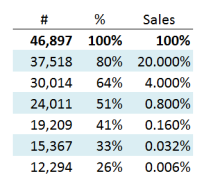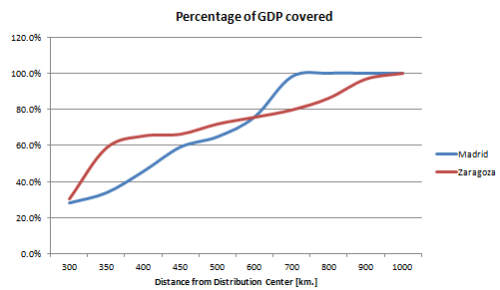How much safety stock to hold? A ubiquitous question in supply chain network design
Alejandro Serrano – Apr 2012 | Spain
When a firm designs from scratch its distribution network, a repetitive question arises sooner or later: should we have a centralized or a decentralized network? In a pure centralized network, a large, central distribution center (CDC) contains all the finished-good inventory of the company. In a pure decentralized setting, inventory for each SKU is splitted among several smaller regional distribution centers (RDC).
One of the key questions mangers usually struggle with when deciding about centralizing inventories or not is how many units of each SKU should be held in each case. It is a relevant question, because holding inventory usually entails significant holding costs, both financial and material.
Let us learn the basics of how to answer that question by means of a very simple example: Assume that the demand of a typical product in the portfolio in a stable market is normally distributed, with mean 400 units/period and standard deviation 80 units/period. The market is divided into four identical regions with independent demand. The firm service level target is 95%, thus in the (assumed current) CDC there should be 532 units to maximize expected profit:
 (If it is not clear to you why this formula is used, please bear with me; it will be explained in a subsequent post)
(If it is not clear to you why this formula is used, please bear with me; it will be explained in a subsequent post)
Now consider that your company is planning to change its distribution strategy from centralized to decentralized, and so you consider having four identical RDCs, one per region. The average demand in any region will be 1/4 of total demand, or 400 / 4 = 100 units. The regional variance will be 1/4 of total variance (assuming demand independence across regions), thus the standard deviation in any region will be
The quantity per RDC is
 The total inventory is 166 x 4 = 633 units. The safety stock needed, i.e., the amount of inventory to hold above the average demand is 532 – 400 = 131.5 units in the centralized case and 633 – 400 = 263 units in the decentralized case. Interestingly, the latter quantity is exactly two times the former. It is not a coincidence that 2 is the squared root of 4. In fact, when switching from 1 to n DCs, overall safety stock is multiplied by √n. For instance, had we considered 9 RDCs, total inventory to hold would have been 400 + 3 x 131.5 = 795 units.
The total inventory is 166 x 4 = 633 units. The safety stock needed, i.e., the amount of inventory to hold above the average demand is 532 – 400 = 131.5 units in the centralized case and 633 – 400 = 263 units in the decentralized case. Interestingly, the latter quantity is exactly two times the former. It is not a coincidence that 2 is the squared root of 4. In fact, when switching from 1 to n DCs, overall safety stock is multiplied by √n. For instance, had we considered 9 RDCs, total inventory to hold would have been 400 + 3 x 131.5 = 795 units.
Of course there may be more involved scenarios (e.g. constraints or demand correlations across regions) that modify the optimal solution. However, keeping in mind this simple square-root formula as a rule of thumb for safety stock will help make back-of-the envelope calculations when quick business decisions have to be made.
To know more about Supply Chain www.zlc.edu.es







